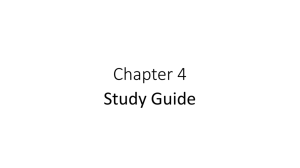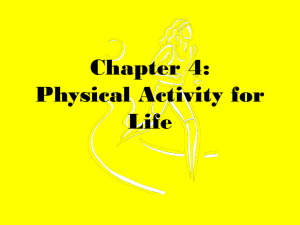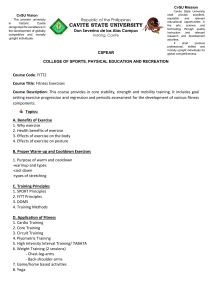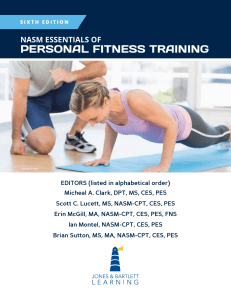Fitness for Life (KIN123-D) Final Study Guide 1)
advertisement
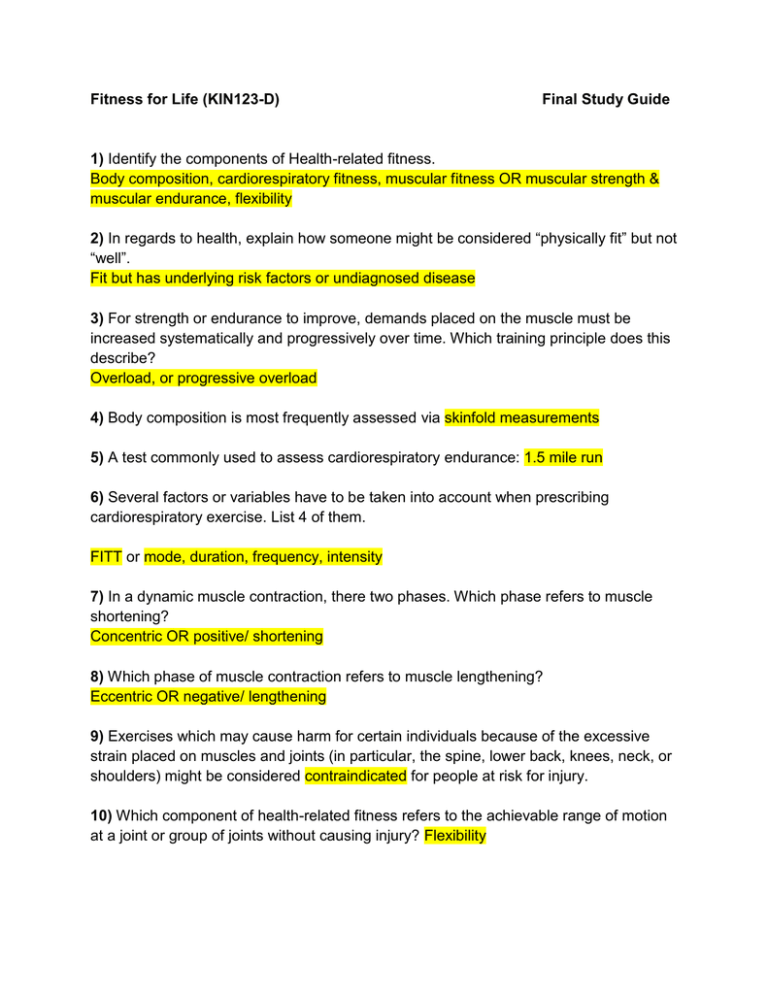
Fitness for Life (KIN123-D) Final Study Guide 1) Identify the components of Health-related fitness. Body composition, cardiorespiratory fitness, muscular fitness OR muscular strength & muscular endurance, flexibility 2) In regards to health, explain how someone might be considered “physically fit” but not “well”. Fit but has underlying risk factors or undiagnosed disease 3) For strength or endurance to improve, demands placed on the muscle must be increased systematically and progressively over time. Which training principle does this describe? Overload, or progressive overload 4) Body composition is most frequently assessed via skinfold measurements 5) A test commonly used to assess cardiorespiratory endurance: 1.5 mile run 6) Several factors or variables have to be taken into account when prescribing cardiorespiratory exercise. List 4 of them. FITT or mode, duration, frequency, intensity 7) In a dynamic muscle contraction, there two phases. Which phase refers to muscle shortening? Concentric OR positive/ shortening 8) Which phase of muscle contraction refers to muscle lengthening? Eccentric OR negative/ lengthening 9) Exercises which may cause harm for certain individuals because of the excessive strain placed on muscles and joints (in particular, the spine, lower back, knees, neck, or shoulders) might be considered contraindicated for people at risk for injury. 10) Which component of health-related fitness refers to the achievable range of motion at a joint or group of joints without causing injury? Flexibility 11) A form of exercise utilizing high- to very high-intensity intervals interspersed with low- to moderate-intensity recovery is known as: High Intensity Interval Training (HIIT) 12) A form of exercise combining two or more activities (such as aerobic and resistance training exercise) to improve fitness and reduce risk of overuse injury: Circuit Training 13) When walking for exercise, a speed of at least 4 mph is recommended to obtain health benefits. 14) Strength training may help increase Basal Metabolic Rate by approximately _________ calories per day. a) 70-100 b) 6-35 c) 100-150 d) 10-15 15) The hormone that influences body weight by increasing appetite is __________ and is made by the stomach. The hormone that decreases appetite is __________ and is made predominantly by fat cells. a) lysine, leucine b) leucine, lysine c) leptin, ghrelin d) ghrelin, leptin 16) The lowest level of caloric intake necessary to sustain life is _________. a) basal metabolic rate b) thermic effect of food c) limit expenditure d) baseline limit rate 17) In regards to HIIT training, the numbers 1:3, 1:2, and 1:1 are examples of: a) working-to-training ratios b) intensity ratios c) work-to-recovery ratios d) recovery-to-work ratios 18) Physicians working with cardiac patients frequently use a unit of measure known as METs to measure the intensity of activities. (hint: this is often displayed on cardio equipment) 19) The _____________ suggests balancing food intake against output allows a person to achieve recommended weight. a) equation of obstetrics b) energy balance equation c) metabolism balance equation d) law of thermodynamics 20) For the sake of health, rather than pursue an “ideal weight”, it may be beneficial for obese or overweight individuals to pursue a healthier body weight known as __________ weight. a) upper tolerance b) lower tolerance c) BMI appropriate d) tolerable 21) A well-designed aerobic workout is divided into three parts. List these 3 parts: 5-10 minute warm-up, 20-60 minute workout at target heart rate, 5-10 minute cool-down 22). When lifestyle behavior changes need to be made, it is most important for the change to be desired by _____________. a) Family members b) The person making the change c) Close friends d) Friends and family 23). Fluid needs can vary drastically between individuals based on body weight, activity levels, sweat rate, etc. Therefore, hydration guidelines (aka, drinking guidelines) should respect this simple recommendation: a) Drink 6-8oz. of water every 15-20 minutes b) Drink 10-12 oz. every 15-20 minutes c) Drink when you’re thirsty d) Drink non-stop while exercising True or False: 24). F Muscle can turn into fat if you don’t exercise 25). F Soreness is caused by lactic acid build-up in the muscles 26). T Calorie-free energy drinks can provide the sensation of having extra energy due to caffeine’s Central Nervous System stimulant effects. 27). F Stretching your muscles contributes to weight loss. 28). F During pregnancy, it’s healthy for women to gain at least 50lbs to support the baby’s growth and development. 29). Describe what causes muscle soreness. Include any relevant definitions or acronyms: Delayed Onset Muscle Soreness (DOMS) – microtears in the muscle fibers 30). The “core” muscles include the muscles of the trunk, spine, and hips.
